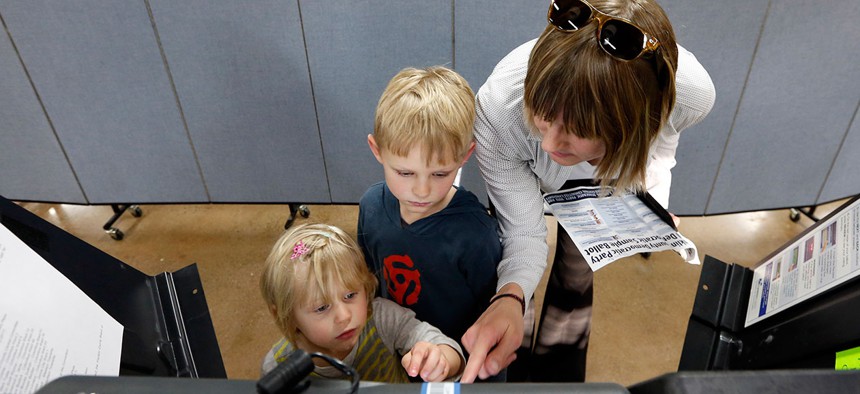A newly released survey by the Woodrow Wilson National Fellowship Foundation illustrates the sorry state of civics education today: Just one in three Americans would pass the U.S. citizenship test. It’s not a test known for its difficulty: The vast majority of citizenship-seeking immigrants pass easily. (A real question on the test: “Identify whether Rhode Island, Oregon, Maine, or South Dakota is a state that borders Canada.”) Only 13 percent of the 1,000 survey respondents, nearly all American-born, could say when the Constitution was ratified (1788, if you were wondering), and fewer than half could identify which countries the U.S. fought against in World War II. Among the most egregious examples from the survey: 2 percent of respondents identified climate change as the cause of the Cold War.

Liv Gjestvang, right, has her kids Solveig Applegate, left, and Karsten Applegate help with voting in Ohio in 2016. Jay LaPrete/AP
The Hidden Costs of Decades of Declining Civics Education
Youth voter turnout is notoriously low in the U.S.; especially when social studies classes are notably absent.
It’s widely known that young adults in the United States tend to vote at lower rates than older Americans, but it’s easy to gloss over just how stunning the numbers really are—especially at a time of such intense political polarization and divisiveness. Only half of eligible adults between the ages of 18 and 29voted in the 2016 presidential election that sent Donald Trump to the White House. During the 2014 midterm elections two years earlier, the youth-voter-turnout rate was just 20 percent, the lowest ever recorded in history, according to an analysis of Census data.
These troubling voting rates follow decades of declining civics education. Starting in the 1960s, robust civics instruction, which usually took place through three standard high-school courses, started to atrophy. It’s likely not a coincidence, then, given evidence suggesting a link between civics education and voter participation, that the 1960s coincided with a slump in the rate of young adults who cast ballots, too.
According to a report published earlier this year, just nine states and the District of Columbia require one year of government or civics classes in high school. But beyond that, most existing civics-education efforts focus on kids in high school and college who are of voting age or close to it—not younger children. For example, one of the most high-profile national initiatives to improve civics education in recent years has homed in on the tail end of the K-12 trajectory, seeking to make passage of the U.S.-citizenship test a graduation requirement nationwide. Today, 29 states have some kind of citizenship-test law on the books, according to Lucian Spataro, the CEO of the group Civics Education Initiative.
Some observers emphasize that to really ensure that kids learn the importance of civics, schools should start lessons much earlier. Ideally, says Kei Kawashima-Ginsberg of Tufts University’s Center for Information and Research on Civic Learning and Engagement, civic engagement should inspire students to translate knowledge about government and policymaking into action—from volunteering and community organizing to lobbying and voting. For kids to really understand that connection, advocates say civics learning should start at a young age.
Only a couple of states, such as Florida, have civic education requirements for middle schoolers, even though that’s when students nationwide take a standardized civics test as part of the National Assessment of Educational Progress. Middle school is also a time in students’ education trajectory that is better structured for such education than later stages, when school becomes broken down into more distinct disciplines that make it difficult to integrate this kind of instruction seamlessly, says Kawashima-Ginsberg. And kids at this age undergo dramatic developmental and intellectual changes that render them particularly ripe for understanding the importance of civics. Likewise, if high school is the first time kids get exposure to the subject matter, teachers may struggle to motivate them. Other advocates go even farther, saying civics lessons should start as early as kindergarten, when kids begin to read and discuss identity.
This type of early civics education might connect with students more easily if it’s woven into the existing fabric of everyday schooling—for example, into a science lesson on pollution, or a history class where students are learning about Native Americans. Civics should’t just be taught in one separate class, it should be a staple of education, “the lima beans on the curricular plate of the elementary student’s day,” as Paul Fitchett, an education professor at the University of North Carolina at Charlotte, put it in a interview with the education-news outlet Chalkbeat.
That Florida requires schools to introduce civics in elementary school may help to explain why the state has seen steady improvement in students’ civics proficiency: In 2017, 70 percent of seventh-graders passed the state exam, up from 61 percent in 2014. And a Washington Monthly article even attributed the activism of teens at Parkland, Florida’s Marjory Stoneman Douglas High School—where 17 students were shot and killed in February— to the state’s early civics requirement. In launching a nationwide movement for stronger gun control, wrote the authors Frank Islam and Ed Crego, the students have “been the beneficiaries of what is arguably one of the nation’s most comprehensive and successful efforts to teach civic knowledge and engagement.”
Besides the Parkland teens, young people have been especially enthusiastic about politics of late, but it means little unless unless they translate it into a trip to the ballot box in November. And the early signs aren’t promising: A recent poll from Gallup indicates that just 26 percent of 18-to-29-year-olds say they intend to vote in the November midterms, compared to 82 percent of Americans 65 and older.






